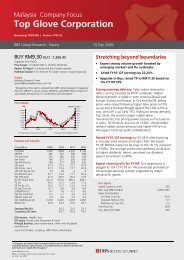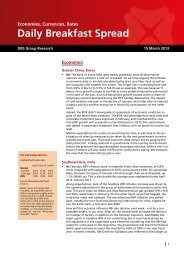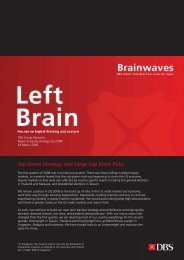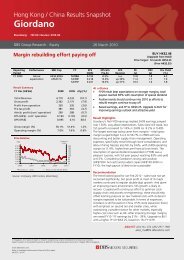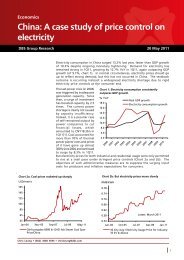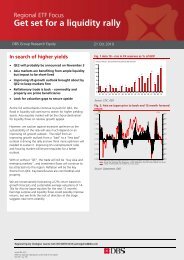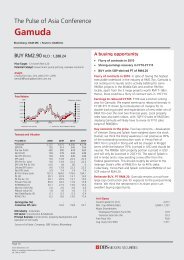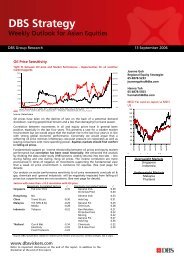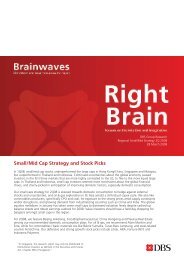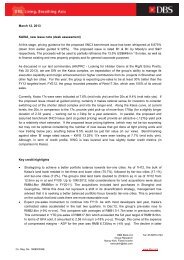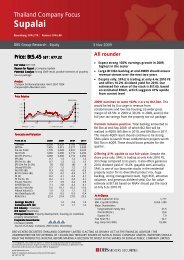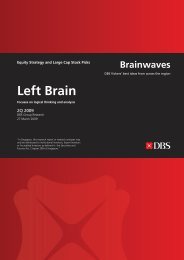Left Brain Right B - the DBS Vickers Securities Equities Research
Left Brain Right B - the DBS Vickers Securities Equities Research
Left Brain Right B - the DBS Vickers Securities Equities Research
Create successful ePaper yourself
Turn your PDF publications into a flip-book with our unique Google optimized e-Paper software.
Regional Equity Strategy 4Q 2009<br />
Strategy Overview: Asia Equity<br />
Asia-vu (2): back to <strong>the</strong> ‘90s (David Carbon, davidcarbon@dbs.com, extracted from “Economics – Markets –<br />
Strategy, 4Q09” dated 17 September 2009)<br />
• Asia’s V-shaped recovery continues, with no help<br />
from <strong>the</strong> US<br />
• This has surprised <strong>the</strong> conventional wisdom (CW),<br />
which thought <strong>the</strong> US would have to lead Asia out of<br />
recession<br />
• Ra<strong>the</strong>r than accept defeat, <strong>the</strong> CW has doubled its<br />
bets: it now believes Asia will face slow growth for<br />
several years<br />
• We think <strong>the</strong> opposite: Growth in Asia over <strong>the</strong> next<br />
5 years will be faster than average, not slower. More<br />
generally, we think Asia is headed back to a period<br />
that resembles <strong>the</strong> early-90s in many ways<br />
• Besides faster growth, capital inflows and a marked<br />
shift toward external deficit will be key features of<br />
<strong>the</strong> next 5-10 years<br />
• Structural, cyclical and ‘new world’ factors will drive<br />
this shift<br />
This report picks up where Asia-vu (1) left off (p3, <strong>DBS</strong><br />
Quarterly, Economics-Markets-Strategy, 15Jun07). As noted,<br />
our bottom line is that everything seems poised to change back<br />
again. In short, if we call <strong>the</strong> 10 years before and after <strong>the</strong> ‘97<br />
crisis P1 and P2, Asia now appears on <strong>the</strong> verge of entering a<br />
third period, P3, which looks an awful lot like P1 (first chart on<br />
right). As Mr Berra might have said, Asia-vu again.<br />
But what does it matter? And why bo<strong>the</strong>r with all this P1 and<br />
P2? The answer to <strong>the</strong> first question is clear: if Asia is headed<br />
back into boom times that’s worth knowing about. Why P1<br />
and P2? Because, <strong>the</strong> longer-term perspective offers a clear<br />
framework for understanding where Asia has been, where it is<br />
going and why. And, because it makes it easy to dispatch with<br />
some of <strong>the</strong> conventional wisdoms that interfere with that<br />
understanding, including:<br />
1. <strong>the</strong> premise that growth in Asia has been “fast” of<br />
late and that little headroom remains for faster<br />
growth ahead;<br />
2. <strong>the</strong> premise that current account surpluses are<br />
responsible for Asia’s “fast” growth and that deficits<br />
would imply slower growth;<br />
3. <strong>the</strong> premise that lower consumption / higher savings,<br />
in <strong>the</strong> US for example, implies slower growth ahead;<br />
and finally, <strong>the</strong> CW conclusion,<br />
4. that Asia is destined for a period of slow growth<br />
ahead.<br />
Asia-vu: back to <strong>the</strong> 90s<br />
Asian<br />
financial<br />
crisis<br />
US<br />
financial<br />
crisis<br />
Period 1 Period 2 Period 3<br />
Capital inflow<br />
Current acct deficits<br />
Rising leverage<br />
Rising external debt<br />
Rapid fixed capital form'n<br />
Above-avg GDP growth<br />
Capital outflow<br />
Current acct surpluses<br />
De-leveraging<br />
Repaying external debt<br />
Paltry fixed capital form'n<br />
Below-avg GDP growth<br />
Asia-vu:<br />
A return to period 1:<br />
Capital inflow<br />
External balance / deficit<br />
Above-avg GDP growth<br />
1987 1997 2007 2017<br />
P1, P2 and <strong>the</strong> Asian myths<br />
Let’s begin. There are 5-6 features of P1 and P2 that will help<br />
us understand what is and is not going on. We considered<br />
<strong>the</strong>m in detail in Asia-vu (1) so let’s take <strong>the</strong> bullet point / chart<br />
approach here:<br />
Growth (chart below): The first myth to address is <strong>the</strong> idea<br />
that growth in Asia has been unusually / unsustainably fast of<br />
late. In fact, growth has been below average for <strong>the</strong> past ten<br />
years. If you want to see fast growth, look at P1, <strong>the</strong> 10 years<br />
leading up to <strong>the</strong> crisis. Growth averaged 8% per year in <strong>the</strong><br />
Asia-9 <strong>the</strong>n. Since <strong>the</strong>n, growth has averaged only 4.7%. Even<br />
in <strong>the</strong> past 5 years it has averaged only 6%. That’s less than<br />
<strong>the</strong> full period average of 6.3% and a full two points below<br />
growth in P1. The next time someone tells you that growth out<br />
here has been running too fast, look <strong>the</strong>m in <strong>the</strong> face and say,<br />
not really.<br />
Asia 9 – average GDP growth<br />
% per year, simple avg<br />
9<br />
8<br />
7<br />
6<br />
5<br />
4<br />
3<br />
2<br />
8.0<br />
Full period average: 6.3%<br />
4.7<br />
87-96 97-08 past 5 yrs<br />
Current account balances: Perhaps <strong>the</strong> most noticeable<br />
change between P1 and P2 was <strong>the</strong> swing in current account<br />
balances. The Asia-9 ran deficits in <strong>the</strong> pre-crisis period<br />
averaging 2% of GDP by 1995. The crisis-4 countries (TH, MY,<br />
ID, KR) ran higher deficits of 6% of GDP and in some instances<br />
6.0<br />
“This report has been re-printed with permission from <strong>DBS</strong> Group <strong>Research</strong><br />
(Regional Equity Strategy) of <strong>DBS</strong> Bank Limited” disclosures on page 37 of this report<br />
Page 21



